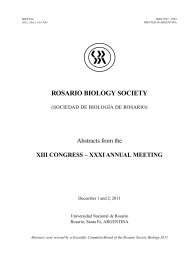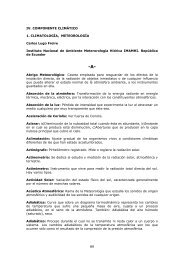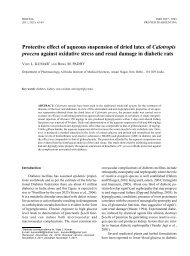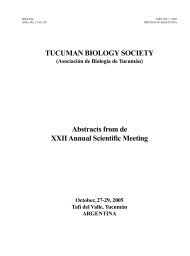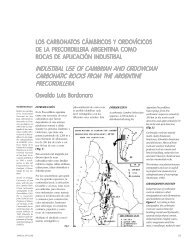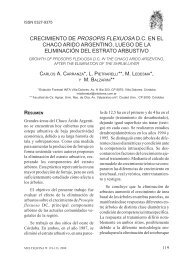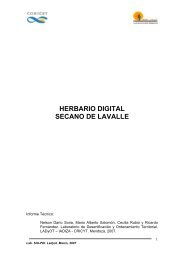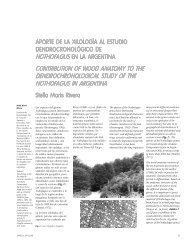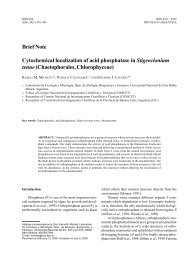Determination of vanadium accumulation in onion root cells - Cricyt
Determination of vanadium accumulation in onion root cells - Cricyt
Determination of vanadium accumulation in onion root cells - Cricyt
You also want an ePaper? Increase the reach of your titles
YUMPU automatically turns print PDFs into web optimized ePapers that Google loves.
BIOCELL<br />
2006, 30(2): 259-267<br />
<strong>Determ<strong>in</strong>ation</strong> <strong>of</strong> <strong>vanadium</strong> <strong>accumulation</strong> <strong>in</strong> <strong>onion</strong> <strong>root</strong> <strong>cells</strong><br />
(Allium cepa L.) and its correlation with toxicity<br />
LETTY MARCANO, INGRID CARRUYO, YUSMARY FERNÁNDEZ, XIOMARA MONTIEL, AND ZAIDA TORREALBA.<br />
Universidad del Zulia. Facultad Experimental de Ciencias. Departamento de Biología. Maracaibo. Estado Zulia. Venezuela.<br />
Key words: Root <strong>cells</strong>, <strong>vanadium</strong>, toxicity, <strong>accumulation</strong>, GFAAS.<br />
Introduction<br />
ABSTRACT: The <strong>vanadium</strong> is a metal that presents great <strong>in</strong>terest from the toxicological po<strong>in</strong>t <strong>of</strong> view,<br />
because <strong>of</strong> the numerous alterations that can take place <strong>in</strong> different biological systems. This work evaluated<br />
the capacity <strong>of</strong> <strong>vanadium</strong> <strong>accumulation</strong> and its correlation with genotoxic effects <strong>in</strong> <strong>root</strong> <strong>cells</strong> <strong>of</strong> Allium cepa<br />
L. The bulbs were cultivated <strong>in</strong> renovated filtered water each 24 h, at a temperature <strong>of</strong> 25 ± 0.5°C, <strong>in</strong> darkness<br />
and constant aeration. Treatments were carried out under the same experimental conditions, us<strong>in</strong>g water<br />
solutions <strong>of</strong> <strong>vanadium</strong> <strong>of</strong> 25, 50, 75 and 100μg/g for 0, 12, 24, 48 and 72 h. A control was carried out where<br />
metal solution was substituted by distilled water. After the treatment, the meristems were fixed with alcohol<br />
- acetic acid (3:1) and sta<strong>in</strong>ed accord<strong>in</strong>g to the technique <strong>of</strong> Feulgen. The capacity <strong>of</strong> <strong>accumulation</strong> was<br />
determ<strong>in</strong>ed by GFAAS. The analysis <strong>of</strong> the results revealed an <strong>accumulation</strong> <strong>of</strong> the metal for all times and<br />
concentrations. No correlation was presented among <strong>vanadium</strong> <strong>accumulation</strong>, growth and mitotic <strong>in</strong>dex;<br />
however, positive correlation was given with the <strong>in</strong>duction <strong>of</strong> chromosomic aberrations. In conclusion, <strong>vanadium</strong><br />
is able to <strong>in</strong>duce cytotoxic effect <strong>in</strong> the exposed <strong>root</strong>s, but only genotoxic effect was correlated with<br />
metal <strong>accumulation</strong>.<br />
Vanadium and <strong>vanadium</strong> compounds can be found<br />
<strong>in</strong> the earth’s crust and <strong>in</strong> rocks, some iron ores, and<br />
crude petroleum deposits; it is used <strong>in</strong> mak<strong>in</strong>g steel,<br />
rubber, plastics, ceramics, and other chemicals (WHO,<br />
2001; Wong and Li 2002). Vanadium ma<strong>in</strong>ly enters the<br />
environment from natural sources and from the burn<strong>in</strong>g<br />
<strong>of</strong> fuel oils; it stays <strong>in</strong> the air, water, and soil for a<br />
long time and comb<strong>in</strong>es with other elements and particles<br />
(Miramand and Fowler, 1998).<br />
Address correspondence to: Dra. Letty Marcano. Urbanización<br />
Monte Bello. Av 12 con calle Q Nº 12-21, Maracaibo, Estado Zulia,<br />
VENEZUELA.<br />
Fax: (+58-261) 7483012. E-mail: letty_marcano@hotmail.com;<br />
lettymarcano@cantv.net<br />
Received on November 24, 2004. Accepted on February 17, 2006.<br />
ISSN 0327 - 9545<br />
PRINTED IN ARGENTINA<br />
<strong>Determ<strong>in</strong>ation</strong> <strong>of</strong> <strong>vanadium</strong> content <strong>of</strong> selected<br />
foods showed that beverages, fats, oils, and fresh fruit<br />
and vegetables conta<strong>in</strong>ed the least <strong>vanadium</strong> rang<strong>in</strong>g<br />
from
260<br />
Although the International Chemical Safety Card<br />
(IPCS, 1999) and the Environmental Protection Agency<br />
(U.S.EPA., 2004), have not classified <strong>vanadium</strong> as its<br />
human carc<strong>in</strong>ogenicity, there are reports that conclude<br />
that exposure to <strong>vanadium</strong> pentoxide particles caused<br />
lung neoplasms <strong>in</strong> male rats and possibly <strong>in</strong> female rats,<br />
and <strong>in</strong> male and female mice (NTP, 2002). Animal studies<br />
suggest that <strong>in</strong>take exceed<strong>in</strong>g 10 mg elemental <strong>vanadium</strong><br />
leads to toxicological effects; these studies show<br />
that toxicity has <strong>in</strong>duced hematological, biochemical,<br />
reproductive and developmental changes, excess <strong>vanadium</strong><br />
built up <strong>in</strong> bone, kidney and liver; to cause prooxidative<br />
effects on glutathione, ascorbic acid, lipids<br />
and NADPH (Okeson et al., 2004; Younes and Strubelt,<br />
1991; Dom<strong>in</strong>go, 2002).<br />
Consider<strong>in</strong>g to the vegetables as one <strong>of</strong> the primary<br />
l<strong>in</strong>ks <strong>of</strong> the alimentary cha<strong>in</strong> that are <strong>in</strong> contact with<br />
the contam<strong>in</strong>ation through the polluted soils, our goal<br />
was to determ<strong>in</strong>e the capacity <strong>of</strong> <strong>accumulation</strong> <strong>of</strong> the<br />
<strong>vanadium</strong> <strong>in</strong> <strong>onion</strong> <strong>root</strong> <strong>cells</strong>, us<strong>in</strong>g atomic absorption<br />
spectrometry technique and correlat<strong>in</strong>g the <strong>vanadium</strong><br />
concentration with the genotoxic effect.<br />
Materials and Methods<br />
Condition <strong>of</strong> cultivation and treatments<br />
Healthy and equal-sized bulbs (n = 12 <strong>onion</strong>s), chosen<br />
from a population <strong>of</strong> the common <strong>onion</strong> Allium cepa<br />
L. (2n = 16), were used as study material. These are<br />
considered one <strong>of</strong> the best biological models for the<br />
study <strong>of</strong> environmental pollutants (Fiskesjo, 1985).<br />
Before start<strong>in</strong>g the experiment, the scales <strong>of</strong> the<br />
bulbs and the brownish button plate were removed, and<br />
TABLE 1.<br />
LETTY MARCANO et al.<br />
the r<strong>in</strong>g <strong>of</strong> the <strong>root</strong> primordial was left <strong>in</strong>tact. The bulbs<br />
were allowed to germ<strong>in</strong>ate <strong>root</strong>s by plac<strong>in</strong>g them <strong>in</strong> beakers<br />
filled with filtered water, changed every 24 h, at a<br />
constant temperature <strong>of</strong> 25°C + 0.5°C, and with a cont<strong>in</strong>uous<br />
airflow <strong>of</strong> 10 - 20 ml <strong>of</strong> air per m<strong>in</strong>ute, and<br />
protected aga<strong>in</strong>st direct sun light. Once the <strong>root</strong>s had<br />
reached a length <strong>of</strong> 2 to 3 cm, they were placed <strong>in</strong> an<br />
aqueous solution <strong>of</strong> <strong>vanadium</strong> pentoxide (V 2 O 5 ) at 25,<br />
50, 75 and 100 μg/g for 0, 12, 24, 48 and 72 h. All tests<br />
were performed <strong>in</strong> triplicate, and each comb<strong>in</strong>ation had<br />
its respective control, <strong>in</strong> which the solution <strong>of</strong> <strong>vanadium</strong><br />
was substituted with distilled water.<br />
<strong>Determ<strong>in</strong>ation</strong> <strong>of</strong> <strong>vanadium</strong> <strong>accumulation</strong><br />
The capacity <strong>of</strong> <strong>accumulation</strong> was determ<strong>in</strong>ed by<br />
graphite furnace atomic absorption spectrometry<br />
(GFAAS). For each time and concentration the <strong>root</strong>s<br />
were removed and dehydrated <strong>in</strong> a lyophilizer (Labconco<br />
model Lyph-lock 6) to - 46°C with a pressure 3400 x<br />
10 -3 mBAR, and their dry weight was determ<strong>in</strong>ed. Vanadium<br />
was evaluated after digestion <strong>of</strong> the sample<br />
(0.1g) with concentrated nitric acid <strong>in</strong> closed vessels <strong>of</strong><br />
Teflon <strong>in</strong>to bombs <strong>of</strong> sta<strong>in</strong>less steel (model 4745 Parr<br />
Instrument Company. USA) at 105-110ºC with conventional<br />
heat<strong>in</strong>g (Precision furnace) for 4h. Metal measurements<br />
were calibrated with standards solutions at<br />
0, 10, 25, 50, 75 and 100 μg/g <strong>of</strong> V 2 O 5 diluted with deionized<br />
H 2 O. Lastly, the samples were analyzed by an<br />
atomic absorption spectrometry (Perk<strong>in</strong> Elmer model<br />
3100), equipped with cont<strong>in</strong>uum source hollow cathode<br />
lamp 303-6078 for <strong>vanadium</strong> operated at 40 mA (wavelength<br />
<strong>of</strong> 318.4 nm, spectral banpass 0.7 nm) with an<br />
HGA-600 graphite furnace and an AS-60 autosampler.<br />
Pyrulytic coated graphite tube were used. The <strong>in</strong>jection<br />
Capacity <strong>of</strong> <strong>accumulation</strong> expressed <strong>in</strong> dry weight (mg/g)<br />
<strong>of</strong> the <strong>vanadium</strong> <strong>in</strong> tips <strong>root</strong>s <strong>of</strong> Alium cepa L.<br />
Time (h) 25<br />
Concentration (mg/g)<br />
50 75 100<br />
0 0.814 0.814 0.814 0.814<br />
12 5.068 6.802 11.597 12.431<br />
24 5.917 7.167 12.964 17.045<br />
48 9.054 9.442 13.405 27.256<br />
72 13.654 14.321 15.448 40.900
VANADIUM ACCUMULATION AND TOXICITY<br />
volume was 20 μl. All glassware and plastic materials<br />
were r<strong>in</strong>sed with deionized water for at least 24 h <strong>in</strong><br />
10% v/v HNO 3 and then thoroughly r<strong>in</strong>sed with deionized<br />
water before use. The rehearsals were carried out<br />
<strong>in</strong> triplicate and the same ones were expressed <strong>in</strong> μg/g<br />
<strong>of</strong> dry weight (Bodenseewerk, 1984).<br />
<strong>Determ<strong>in</strong>ation</strong> <strong>of</strong> the effect <strong>of</strong> the <strong>vanadium</strong> on the longitude<br />
Allium cepa bulbs were prepared as described by<br />
Fiskesjo (1985) us<strong>in</strong>g 3 bulbs for all experimental comb<strong>in</strong>ation<br />
treatment and control. When the <strong>root</strong>s were 2<br />
± 0.5 cm long, the bulbs were placed directly <strong>in</strong> the test<br />
liquid which were changed every 24 h. Dur<strong>in</strong>g the <strong>in</strong>cubation<br />
with <strong>vanadium</strong>, the length <strong>of</strong> the <strong>root</strong>s (4 <strong>of</strong><br />
each bulb) was measured us<strong>in</strong>g a millimeter ruler.<br />
<strong>Determ<strong>in</strong>ation</strong> <strong>of</strong> the effect <strong>of</strong> <strong>vanadium</strong> pentoxide on<br />
the Mitotic Index (MI)<br />
For each time <strong>of</strong> exposure and concentration, four<br />
(4) <strong>root</strong>s were cut to carry out the cytologist study. Follow<strong>in</strong>g<br />
treatment, each one were placed <strong>in</strong> a solution <strong>of</strong><br />
ethanol (99%) and glacial acetic acid (3:1) for 24 h,<br />
washed with distilled water three times, and then dyed<br />
<strong>in</strong> acetic-hydrochloric orce<strong>in</strong>. The “squash” technique<br />
was applied for the study <strong>of</strong> MI. An analysis <strong>of</strong> an average<br />
<strong>of</strong> 3,000 <strong>cells</strong> for each <strong>root</strong> tip was performed.<br />
Effect <strong>of</strong> <strong>vanadium</strong> on the <strong>in</strong>duction <strong>of</strong> Chromosomal<br />
Aberrations (ChA)<br />
The <strong>in</strong>duction <strong>of</strong> ChA was determ<strong>in</strong>ed with the<br />
same previous procedure, evaluat<strong>in</strong>g simultaneously the<br />
261<br />
morphological changes <strong>of</strong> the chromosome for each<br />
exposed meristem to the metal and compar<strong>in</strong>g it with<br />
its respective control.<br />
Statistical Analysis<br />
A multivariate analysis <strong>of</strong> variance (MANOVA) was<br />
carried out to determ<strong>in</strong>e which <strong>of</strong> the two factors (time<br />
and concentration) had the greater effect. A student test<br />
analysis was carried out to determ<strong>in</strong>e the dependence<br />
<strong>of</strong> the concentration and the time <strong>of</strong> exposure on the<br />
percentage <strong>of</strong> ChA. Likewise a simple correlation analysis<br />
(Pearson) was carried out to determ<strong>in</strong>e the association<br />
among the <strong>vanadium</strong> <strong>accumulation</strong> with the different<br />
evaluated parameters: longitude, MI, ChA.<br />
The results were analyzed by means <strong>of</strong> the statistical<br />
program STATISTIX V.Y. for W<strong>in</strong>dows.<br />
Results<br />
TABLE 2.<br />
Capacity <strong>of</strong> <strong>accumulation</strong><br />
The results regard<strong>in</strong>g the <strong>accumulation</strong> <strong>in</strong> tip <strong>root</strong>s<br />
<strong>of</strong> Allium cepa exposed at different concentration and<br />
time with the metal are presented <strong>in</strong> Table 1. The sample<br />
controls presented an <strong>accumulation</strong> <strong>of</strong> 0.814 (μg/g) <strong>of</strong><br />
<strong>vanadium</strong>. In the exposed meristems, the metal content<br />
<strong>in</strong> the <strong>root</strong>s ranged from 5.068 to 40.90 μg/g dry weight,<br />
show<strong>in</strong>g a direct relation with the concentration and time<br />
<strong>of</strong> exposure. The results <strong>of</strong> the variance analysis showed<br />
that both effects are significant, but the effect <strong>of</strong> the<br />
concentration was 1.84 times higher than the effect <strong>of</strong><br />
the time <strong>of</strong> contact. However, the <strong>in</strong>teraction <strong>of</strong> both<br />
effects together was not significant (Table 2).<br />
Variance analysis for the effect <strong>of</strong> time and concentration on <strong>vanadium</strong><br />
<strong>accumulation</strong> expressed <strong>in</strong> dry weight (μg/gr)<br />
Variation source DF SS MS F p<br />
Time (A) 3 345.651 115.217 4.96 P < 0.01<br />
Concentration (B) 3 639.109 213.036 9.17 P < 0.05<br />
(AxB) 9 209.038 23.2264 - -
262<br />
Effect on the longitude<br />
It was observed a decrease <strong>in</strong> the longitude <strong>in</strong> the<br />
exposed <strong>root</strong>s (Fig. 1). This effect was dependent on<br />
the time <strong>of</strong> treatment and the concentration. Both effects<br />
are significant, but the effect <strong>of</strong> the times <strong>of</strong> treatment<br />
was 1.13 higher than the effect <strong>of</strong> the concentration<br />
(Table 3).<br />
Effect on the Mitotic Index (MI)<br />
Analysis <strong>of</strong> the results from the effect <strong>of</strong> the concentration<br />
and the time <strong>of</strong> exposure on the MI show a<br />
decrease <strong>in</strong> MI <strong>of</strong> exposed <strong>root</strong>s dependent on the concentration<br />
and time <strong>of</strong> treatment (Fig. 2). Both effects<br />
TABLE 3.<br />
LETTY MARCANO et al.<br />
are significant, but the effect <strong>of</strong> the times <strong>of</strong> treatment<br />
was 4.56 higher than the effect <strong>of</strong> the concentration<br />
(Table 4).<br />
Induction <strong>of</strong> Chromosome Aberrations (ChA)<br />
Table 5 shows the <strong>in</strong>duction <strong>of</strong> ChA for all concentrations<br />
used, which becomes significant (p< 0.01)<br />
beg<strong>in</strong>n<strong>in</strong>g with 12 h <strong>of</strong> exposure. In figure 3, changes<br />
were observed <strong>in</strong> the organization and morphology <strong>of</strong><br />
the chromosomes <strong>in</strong> the <strong>root</strong> tips exposed to metal. It<br />
was observed for all the concentrations and times<br />
longer than 12 h, the <strong>in</strong>duction <strong>of</strong> stick<strong>in</strong>ess (Fig. 3a),<br />
formation <strong>of</strong> anaphasic bridges (Fig. 3b) and c-mitotic<br />
effect (Fig. 3c).<br />
FIGURE 1. Effect <strong>of</strong> Vanadium at different concentrations and times <strong>of</strong> exposure<br />
on the longitude <strong>in</strong> tips <strong>root</strong>s <strong>of</strong> <strong>onion</strong> (Allium cepa l.) SD is marked<br />
Variance analysis for the effect <strong>of</strong> time and concentration <strong>of</strong> <strong>vanadium</strong><br />
on <strong>root</strong>s longitude (cm).<br />
Variation source DF SS MS F P<br />
Time (A) 6 93.2650 15.5442 118.81 P < 0.01<br />
Concentration (B) 4 55.1639 13.7910 105.41 P < 0.01<br />
(AxB) 24 49.0321 2.04301 15.62 P < 0.01
VANADIUM ACCUMULATION AND TOXICITY<br />
Correlation between <strong>accumulation</strong> and deleterious<br />
effect<br />
The correlation analysis <strong>of</strong> the <strong>accumulation</strong> <strong>of</strong> the<br />
metal with the different deleterious effects revealed no<br />
association among the metal accumulated with the longitude<br />
(r = 0.0037; p > 0.05), nor with the mitotic <strong>in</strong>dex<br />
(r = -0.0216; p>0.05); for the case <strong>of</strong> the chromosomal<br />
anomalies, a highly significant positive correlation is<br />
presented with the <strong>accumulation</strong> (r = 0.5423; p < 0.01),<br />
with a coefficient <strong>of</strong> determ<strong>in</strong>ation (R 2 = 0.2940) that<br />
TABLE 4.<br />
Variance analysis for the effect <strong>of</strong> time and concentration <strong>of</strong> <strong>vanadium</strong><br />
on Mitotic Index (%).<br />
Variation source DF SS MS F p<br />
Time (A) 4 851.834 212.958 2913.14 P < 0.01<br />
Concentration (B) 4 186.447 46.6117 637.62 P < 0.01<br />
(AxB) 16 85.5552 5.34720 73.15 P < 0.01<br />
263<br />
<strong>in</strong>dicates that 29.4% <strong>of</strong> the aberrations takes place for<br />
effects <strong>of</strong> the accumulated metal.<br />
Discussion<br />
Capacity <strong>of</strong> <strong>accumulation</strong><br />
There are few studies related to the bio<strong>accumulation</strong><br />
<strong>of</strong> <strong>vanadium</strong>. In general it appears than the organisms<br />
do not concentrate <strong>vanadium</strong> from the environment and<br />
FIGURE 2. Effect <strong>of</strong> Vanadium at different concentrations and times <strong>of</strong> exposure on<br />
the mitotic <strong>in</strong>dex (MI) <strong>in</strong> tips <strong>root</strong>s <strong>of</strong> <strong>onion</strong> (Allium cepa L). SD is marked
264<br />
there is not <strong>in</strong>dication <strong>of</strong> biomagnification <strong>in</strong> the food<br />
cha<strong>in</strong> (WHO, 2001; Mart<strong>in</strong> and Kaplan, 1998), reported<br />
that the reception <strong>of</strong> <strong>vanadium</strong> <strong>in</strong> the <strong>root</strong>s and the leaves<br />
<strong>of</strong> the bean plants is under the detection limits and<br />
Tudares and Villalobos (1998), established that <strong>vanadium</strong><br />
levels <strong>in</strong> plants are low and with many variations<br />
among the species, and each depends directly on the<br />
content <strong>of</strong> the metal <strong>in</strong> the soil and factors like the acidity<br />
and humidity.<br />
The <strong>accumulation</strong> presented <strong>in</strong> the sample controls,<br />
should be taken <strong>of</strong> fresh cultivation, because the bulbs<br />
were acquired <strong>in</strong> the market, be<strong>in</strong>g the same ones were<br />
used for the consumption <strong>of</strong> the populations, this allows<br />
to possibly <strong>in</strong>fer the grade <strong>of</strong> contam<strong>in</strong>ation environmental<br />
product <strong>of</strong> the use <strong>of</strong> the compound agrochemical,<br />
which <strong>in</strong>creases the absorption <strong>in</strong> crops<br />
(Bodenseewerk, 1984).<br />
For the exposed meristems, the analysis revealed<br />
an <strong>accumulation</strong> <strong>of</strong> the metal for all times and concentrations.<br />
It is accentuat<strong>in</strong>g proportionally, reflect-<br />
FIGURE 3. Chromosomal Anomalies (ChA) <strong>in</strong>duced by<br />
<strong>vanadium</strong> <strong>in</strong> tips <strong>root</strong>s <strong>onion</strong> (Allium cepa L).<br />
Fig. 3a. Stick<strong>in</strong>ess (75 μg/g) at 12 h. 1,000 X<br />
Fig. 3b. Telophasic bridges (75 μg/g) at 12 h. 1,000 X<br />
Fig. 3c. C-mitotic effect. (100 μg/g) at 48 h. 1,000 X<br />
LETTY MARCANO et al.<br />
<strong>in</strong>g a bio<strong>accumulation</strong> <strong>of</strong> metal <strong>in</strong> the studied biological<br />
model that is <strong>in</strong> accordance with that reported by<br />
Tudares and Villalobos (1998), who established that<br />
the bio<strong>accumulation</strong> <strong>of</strong> the metal depends on the<br />
physiochemical characteristics <strong>of</strong> the soil, as well as<br />
the studied species. So, the <strong>cells</strong> meristematic <strong>of</strong> Allium<br />
cepa can be considered like a species with a half<br />
capacity <strong>of</strong> bio<strong>accumulation</strong>, <strong>of</strong> toxicological importance<br />
if it is considered that it is part <strong>of</strong> the population<br />
basic diet. Recently reports <strong>of</strong> other plants have been<br />
given as the tobacco, certa<strong>in</strong> mosses (Hypnum<br />
cupressiforme) and some mushrooms (Amanita<br />
muscaria), can accumulate around 100 times more<br />
<strong>vanadium</strong> than other metals (WHO, 2001).<br />
The mechanism <strong>of</strong> cellular <strong>in</strong>corporation <strong>of</strong> <strong>vanadium</strong><br />
is not very well known; however, reports exist that<br />
relate it with certa<strong>in</strong> oligoelements required for the cellular<br />
functions, some <strong>of</strong> which are cations such as z<strong>in</strong>c,<br />
for which the <strong>vanadium</strong> could act as antagonistic<br />
(Okeson et al., 2004). It has also been related with ex-
VANADIUM ACCUMULATION AND TOXICITY<br />
ist<strong>in</strong>g reports that <strong>in</strong> deficiencies <strong>in</strong> iron, it could be<br />
<strong>in</strong>creased the absorption <strong>of</strong> metals like the <strong>vanadium</strong><br />
(NIOSH, 1997).<br />
The results <strong>of</strong> the variance analysis, for the study<br />
<strong>of</strong> the effect <strong>of</strong> the concentration and the time <strong>of</strong> exhibition,<br />
<strong>in</strong> the <strong>accumulation</strong> the metal <strong>of</strong> the <strong>root</strong>s, <strong>in</strong>dicate<br />
that subject<strong>in</strong>g the <strong>root</strong> tips to high concentrations<br />
for a short time leads to more <strong>accumulation</strong> than expos<strong>in</strong>g<br />
them to low concentrations for longer times. This<br />
results are <strong>in</strong> agreement with those reported by Mart<strong>in</strong><br />
and Kaplan (1998) who po<strong>in</strong>ts out that the reception <strong>of</strong><br />
<strong>vanadium</strong> <strong>in</strong> the <strong>root</strong>s and the superior parts <strong>of</strong> bean<br />
plants <strong>in</strong> 18 months <strong>of</strong> experiment was perceptible dur<strong>in</strong>g<br />
the <strong>in</strong>itial period, suggest<strong>in</strong>g the short term<br />
bioread<strong>in</strong>ess.<br />
Effect on the longitude<br />
Analysis <strong>of</strong> the results <strong>of</strong> this study on the effect <strong>of</strong><br />
the concentration and the time <strong>of</strong> exposure to the <strong>vanadium</strong><br />
on the <strong>root</strong>s longitude show a decrease <strong>in</strong> the longitude<br />
<strong>in</strong> the exposed <strong>root</strong>s. It was dependent on the<br />
TABLE 5.<br />
265<br />
concentration and the time <strong>of</strong> treatment. It was observed<br />
that both effects are significant, but the time <strong>of</strong> contact<br />
was higher than the effect <strong>of</strong> the concentration, which<br />
<strong>in</strong>dicates that subject<strong>in</strong>g the <strong>root</strong> tips to low concentrations<br />
for longer times, is more deleterious than expos<strong>in</strong>g<br />
them to high concentrations for a short time. The<br />
results co<strong>in</strong>cide with those reported by Cortizo and<br />
Etcheverry (1995), and Wang and Liu (1999), who po<strong>in</strong>t<br />
out a reduction <strong>of</strong> the growth <strong>in</strong>duced by <strong>vanadium</strong> <strong>in</strong><br />
Iris L and soybean, respectively. On the other hand<br />
(Donghua et al., 1994; Marcano et al., 1999), settle down<br />
that the toxic effect <strong>of</strong> lead and cadmium respectively<br />
<strong>in</strong> the same biological model, reflected by a blockade<br />
<strong>in</strong> the growth <strong>of</strong> the treated <strong>root</strong>s that <strong>in</strong>creases with the<br />
get higher <strong>of</strong> concentration and time <strong>of</strong> exposure.<br />
Effect on the Mitotic Index (MI)<br />
MI is considered a parameter that allows one to<br />
estimate the frequency <strong>of</strong> cellular division. All the experiments<br />
were carried out when the <strong>root</strong>s reached 2 to<br />
3 cm <strong>in</strong> length, at which stage the <strong>root</strong> tips are <strong>in</strong> a dy-<br />
Frequency <strong>of</strong> % chromosomal anomalies <strong>in</strong>duced by <strong>vanadium</strong><br />
<strong>in</strong> meristematics <strong>cells</strong> <strong>of</strong> Allium cepa L.<br />
Chromosomal Time 0 25 50 75 100 TOTAL<br />
anomalies (h) (μg/g) (μg/g) (μg/g) (μg/g) (μg/g) ChA<br />
12 0 7.3 12 46.3 75.3 140.9<br />
Stick<strong>in</strong>ess 24 0 7.3 12 42 64 125.3<br />
48 0 10 33 37.3 53.3 133.6<br />
72 0 12.6 30.3 27.3 24 94.2<br />
12 0 0 0 0.83 2 2.83<br />
Chromosomic 24 0 0 0 1.16 2.33 4.19<br />
Bridges 48 0 0 0 2.5 2.16 4.66<br />
72 0 0 0 2 1.66 3.66<br />
12 0 0 0 0 0 0<br />
24 0 0 0 0 0 0<br />
C-mitosis 48 0 0 0 0 13 13<br />
72 0 0 0 0 21 21
266<br />
namic balance, when the number <strong>of</strong> <strong>cells</strong> <strong>in</strong> the division<br />
phase are equal to the number <strong>of</strong> <strong>cells</strong> <strong>in</strong> the differentiation<br />
phase.<br />
Analysis <strong>of</strong> the results from the effect <strong>of</strong> the concentration<br />
and the time <strong>of</strong> exposure on the MI, showed<br />
a decrease <strong>in</strong> % MI <strong>of</strong> exposed <strong>root</strong>s. It was dependent<br />
on the concentration and time <strong>of</strong> treatment. Both effects<br />
are significant, but the effect <strong>of</strong> time <strong>of</strong> contact<br />
was higher than the effect <strong>of</strong> the concentration, which<br />
<strong>in</strong>dicates that subject<strong>in</strong>g the <strong>root</strong> tips to high time for<br />
low concentrations is more deleterious than expos<strong>in</strong>g<br />
them to high concentrations for short times (Dom<strong>in</strong>go,<br />
2002), reported a reduction statistically significant <strong>of</strong><br />
the mitotic <strong>in</strong>dex <strong>in</strong>duced by <strong>vanadium</strong> <strong>in</strong> human lymphocyte<br />
cultures. On the other hand, Donghua et al.<br />
(1994), Marcano et al. (1999) and Wierzbicka (1999),<br />
reported <strong>in</strong> the same biological model the blockade <strong>in</strong>duced<br />
by other heavy metals <strong>in</strong> the exposed <strong>cells</strong>, co<strong>in</strong>cid<strong>in</strong>g<br />
with the reports that po<strong>in</strong>t out the toxicity <strong>of</strong> the<br />
metal <strong>in</strong> diverse biological systems (Migliore et al.,<br />
1993; Owusu-Yaw et al., 1990; NTP, 2002; Okeson et<br />
al., 2004).<br />
Induction <strong>of</strong> Chromosome Aberrations (ChA)<br />
The results <strong>of</strong> these experiments show a clastogenic<br />
effect, evidenced by the <strong>in</strong>duction <strong>of</strong> ChA for the concentrations<br />
used, which becomes significant (p< 0.01)<br />
beg<strong>in</strong>n<strong>in</strong>g with 12 h <strong>of</strong> exposure. For all the concentrations<br />
and times longer than 12 h, the <strong>in</strong>duction <strong>of</strong> stick<strong>in</strong>ess<br />
was evidenced. This phenomenon has been reported<br />
as <strong>in</strong>dicative <strong>of</strong> high toxicity (Marcano et al., 1998).<br />
Other anomalies observed were formation <strong>of</strong> anaphasic<br />
bridges and c-mitotic effect, possibly for the effect <strong>of</strong><br />
<strong>vanadium</strong> <strong>in</strong>hibit<strong>in</strong>g the formation <strong>of</strong> the mitotic sp<strong>in</strong>dle<br />
followed by random scatter<strong>in</strong>g <strong>of</strong> the condensed chromosome<br />
(Owusu-Yaw et al., 1990). These anomalies<br />
are considered <strong>in</strong>ductor aneuploids and poliploids<br />
(Marcano et al., 1998).<br />
The Student test analysis for related samples determ<strong>in</strong>ed<br />
a significant dependence on the concentration,<br />
the time <strong>of</strong> exposure and the percentage <strong>of</strong> ChA (p <<br />
0.01); these <strong>in</strong>crease proportionally to the <strong>in</strong>crease <strong>of</strong><br />
the concentration and the time <strong>of</strong> exposure, until they<br />
reach a po<strong>in</strong>t that, because <strong>of</strong> the block<strong>in</strong>g effect <strong>of</strong> MI,<br />
the % <strong>of</strong> ChA beg<strong>in</strong>s to decrease. Similar results have<br />
been reported <strong>in</strong> other biological systems (Zhong et al.,<br />
1994; Okeson et al., 2004). The clastogenicity <strong>in</strong>duced<br />
by the metal can cause cellular death, due to its effect<br />
on the <strong>in</strong>duction <strong>of</strong> DNA strand breaks (Migliore et al.,<br />
1993; Chan and Kim, 1993).<br />
LETTY MARCANO et al.<br />
Correlation between <strong>accumulation</strong> and deleterious<br />
effect<br />
The correlation analysis <strong>of</strong> the <strong>accumulation</strong> <strong>of</strong><br />
the metal with the different deleterious effects could<br />
support the hypothesis that <strong>vanadium</strong> does not affect<br />
these two parameters directly. Possibly the <strong>in</strong>hibitory<br />
effect on the same ones can be related with the route<br />
<strong>of</strong> absorption <strong>of</strong> nutritious necessary for the growth<br />
<strong>of</strong> the meristems. In this respect, there have been<br />
reported harmful effects <strong>of</strong> <strong>vanadium</strong> (10 - 20 mg/L)<br />
on the plants, alter<strong>in</strong>g the process <strong>of</strong> nitrogen fixation<br />
(WHO, 2001).<br />
For the case <strong>of</strong> the chromosomal anomalies, the<br />
results <strong>in</strong>dicate that the accumulated metal can act <strong>in</strong><br />
the mechanisms <strong>in</strong>volved <strong>in</strong> DNA repair. This is supported<br />
by reports that establish that the metal <strong>in</strong>terferes<br />
with the enzymatic complexes <strong>of</strong> molybdenum and iron<br />
(Chan and Kim, 1993; Tudares and Villalobos, 1998),<br />
caus<strong>in</strong>g disorders at cellular level that can bear to damages<br />
to DNA. Nielsen and Uthus (1990), report the narrow<br />
similarity <strong>of</strong> <strong>vanadium</strong> with phosphorus and the<br />
impact that this exercises on phosphorylation reactions,<br />
<strong>in</strong>dispensable processes <strong>in</strong> the regulation <strong>of</strong> the cellular<br />
cycle, for what can settle down the genotoxic effect taken<br />
place by the <strong>vanadium</strong> is directly related with the penetration<br />
power and <strong>accumulation</strong> <strong>of</strong> the metal, as well<br />
as their <strong>in</strong>teraction with enzymes required for diverse<br />
metabolic processes (Yang et al., 2004; Okeson et al.,<br />
2004). These results agree with reports <strong>in</strong> other biological<br />
systems (Miramand and Fowler, 1998; Abdallah<br />
and Moustafa, 2002).<br />
Conclusions<br />
The capacity <strong>of</strong> <strong>accumulation</strong> <strong>of</strong> <strong>vanadium</strong> was<br />
demonstrated <strong>in</strong> the studied biological model, for what<br />
we can suggest as a good model for studies <strong>of</strong> contam<strong>in</strong>ation<br />
for heavy metals. Equally, an <strong>in</strong>hibitory effect <strong>of</strong><br />
<strong>vanadium</strong> on the growth <strong>of</strong> the meristems and the mitotic<br />
<strong>in</strong>dex was showed, as well as the <strong>in</strong>duction <strong>of</strong> chromosomal<br />
aberrations. However, the analysis correlation<br />
<strong>of</strong> the <strong>accumulation</strong> <strong>of</strong> the metal with the different deleterious<br />
effects revealed no association among the metal<br />
accumulated with the longitude, nor with the mitotic<br />
<strong>in</strong>dex. Nevertheless, a direct correlation among the accumulative<br />
metal and the <strong>in</strong>duction <strong>of</strong> chromosomal<br />
anomalies was showed (genotoxic effect). It is recommended<br />
to carry out future studies relat<strong>in</strong>g the <strong>vanadium</strong><br />
<strong>accumulation</strong> with their toxicity <strong>in</strong> other biologi-
VANADIUM ACCUMULATION AND TOXICITY<br />
cal models to try to elucidate the different biological<br />
roles <strong>of</strong> the element.<br />
Acknowledgments<br />
This work was f<strong>in</strong>anced by the Consejo de<br />
Desarrollo Científico y Humanístico <strong>of</strong> the University<br />
<strong>of</strong> Zulia - Venezuela. We also thank Mr. Johan Mesa for<br />
his assistance technique. Special thanks to Bradley W.<br />
Christian for correction on English grammar.<br />
References<br />
Abdallah M, Moustafa A (2002). Accumulation <strong>of</strong> lead and cadmium<br />
<strong>in</strong> the mar<strong>in</strong>e prosobranch Nerita saxtilis, light and electron<br />
microscopy. Environ Pollut. 116: 185-191.<br />
Bodenseewerk J (1984). Analytical techniques for Grafite Furnace<br />
Atomic Absorption <strong>in</strong> Spect<strong>of</strong>ometry Perk<strong>in</strong>-Elmer GMGH.<br />
Verberl<strong>in</strong>ge, Republic Federal <strong>of</strong> Germany.<br />
Chan M, Kim J (1993). The nitrogenase FeMo-c<strong>of</strong>actor and P-cluster<br />
pair: 2.2 Å resolution structure. Science. 260: 792-794.<br />
Cortizo M, Etcheverry B (1995). Vanadium derivatives act as growth<br />
factor mimetic compounds upon differentiation and proliferation<br />
<strong>of</strong> osteoblast-like UMR106 <strong>cells</strong>. Mol Cell Biochem.<br />
145: 7-10.<br />
Dom<strong>in</strong>go JL (2002). Vanadium and tungsten derivatives as antidiabetic<br />
agents. Biol Trace Elem Res. 88: 97-112.<br />
Donghua L, Wusheng J, Wei W, Fengmel Z, Cheng L (1994). Effects<br />
<strong>of</strong> lead on <strong>root</strong> growth, cell division, and nucleolus <strong>of</strong><br />
Allium cepa. Environ Pollut. 86: 1-4.<br />
Fiskesjo G (1985). The Allium test as a standard <strong>in</strong> environmental<br />
monitor<strong>in</strong>g. Hereditas. 102: 99-112.<br />
IPCS. (1999) International Chemical Safety Card — Vanadium<br />
pentoxide. Geneva, World Health Organization, International<br />
Programme on Chemical Safety (ICSC 0596).<br />
Marcano L, Carruyo I, Montiel X, Bracho M, Soto L (1999).<br />
Valoración del efecto tóxico del cadmio en células<br />
meristemáticas de cebolla (Allium cepa). Rev Fac Agro LUZ.<br />
16: 476-487.<br />
Marcano L, Montiel X, Carruyo I, Bracho M, Atencio L (1998).<br />
Efecto mitotóxico y genotóxico del cadmio en células<br />
meristemáticas de cebolla (Allium cepa L.). Ciencia 6: 93-<br />
99.<br />
Mart<strong>in</strong> H, Kaplan D (1998). Temporal changes <strong>in</strong> cadmium, thallium,<br />
and <strong>vanadium</strong> mobility <strong>in</strong> soil and phytoavailability<br />
under field conditions. Water, air, soil pollut. 101: 399-410.<br />
267<br />
Migliore L, Bocciardi R, Macri C, Lo Jacono F (1993). Cytogenetic<br />
damage <strong>in</strong>duced <strong>in</strong> human lymphocytes by four <strong>vanadium</strong><br />
compounds and micronucleus analysis by fluorescence<br />
<strong>in</strong> situ hybridisation with a centromeric probe. Mutat Res.<br />
319: 205-213.<br />
Miramand P, Fowler S (1998). Bio<strong>accumulation</strong> and transfer <strong>of</strong><br />
<strong>vanadium</strong> <strong>in</strong> mar<strong>in</strong>e organisms. In: Vanadium <strong>in</strong> the environment.<br />
Part 1: Chemistry and biochemistry. Nriagu J, Ed., John<br />
Wiley & Sons. New York. pp. 167-197.<br />
Mukherjee B, Patra B, Mahapatra S, Banerjee P, Tiwari A, Chatterjee<br />
M (1999). Vanadium an element <strong>of</strong> atypical biological significance.<br />
Environ Pollut. 106: 249-251.<br />
Nielsen F, Uthus E (1990). The essentiality and metabolism <strong>of</strong> <strong>vanadium</strong>.<br />
In: Vanadium <strong>in</strong> biological systems. Chasteen N, Ed.,<br />
Kluwer Academic Press. Dordrecht. pp. 51-62.<br />
NIOSH (1997). Occupational exposure to <strong>vanadium</strong>. Wash<strong>in</strong>gton,<br />
DC, National Institute for Occupational Safety and Health.<br />
(Document No. 77-222). 142 pp<br />
NTP (2002). National Toxicology Program. Technical report on the<br />
toxicology and carc<strong>in</strong>ogenesis studies <strong>of</strong> <strong>vanadium</strong> pentoxide<br />
(cas no. 1314-62-1) <strong>in</strong> f344/n rats and b6c3f1 mice (<strong>in</strong>halation<br />
studies). U.S. Department <strong>of</strong> Health and Human Services.<br />
Okeson LD, Riley M, Riley-Saxton E (2004). In vitro alveolar cytotoxicity<br />
<strong>of</strong> soluble components <strong>of</strong> airborne particulate matter:<br />
effects <strong>of</strong> serum on toxicity <strong>of</strong> transition metals. Toxicology<br />
<strong>in</strong> Vitro. 18: 673-680.<br />
Owusu-Yaw J, Cohen M, Fernando S, Wei C (1990). An assessment<br />
<strong>of</strong> the genotoxicity <strong>of</strong> <strong>vanadium</strong>. Toxicol Lett. 50: 327-<br />
336.<br />
Tudares C, Villalobos H (1998). Determ<strong>in</strong>ación de la concentración<br />
de vanadio en alimentos procedentes de La Costa Oriental<br />
del Lago de Maracaibo. Inv. Clínicas. 39: 29-38.<br />
U.S.EPA (2004). Environmental Protection Agency. Great Lakes<br />
Pollution Prevention and Toxics Reduction.<br />
Wang J, Liu Z (1999). Effect <strong>of</strong> <strong>vanadium</strong> on the growth <strong>of</strong> soybean<br />
seedl<strong>in</strong>g. Plant and soil. 216: 47-51.<br />
WHO (2001). Environmental health criteria 118: Inorganic <strong>vanadium</strong>.<br />
World Health Organization. 169.<br />
Wierzbicka M (1999). Comparison <strong>of</strong> lead tolerance <strong>in</strong> Allium cepa<br />
with other plant species. Environ Pollut. 104: 41-52.<br />
Wong C, Li X (2002). Heavy metals <strong>in</strong> agricultural soils <strong>of</strong> Pearl<br />
River Delta, South Ch<strong>in</strong>a. Environ Pollut. 119: 33-44.<br />
Yang X, Yuan L, Wang K, Crans D (2004). The permeability and<br />
cytotoxicity <strong>of</strong> <strong>in</strong>sul<strong>in</strong>-mimetic <strong>vanadium</strong> compounds. Pharm<br />
Res. 21: 1026-33.<br />
Younes M, Strubelt O (1991). Vanadate-<strong>in</strong>duced toxicity towards<br />
isolated perfused rat livers: The role <strong>of</strong> lipid peroxidation.<br />
Toxicol. 66: 63-74.<br />
Zhong B, Gu Z, Wallace W, Whong T (1994). Genotoxicity <strong>of</strong> <strong>vanadium</strong><br />
pentoxide <strong>in</strong> Ch<strong>in</strong>ese hamster V79 <strong>cells</strong>. Mutat Res.<br />
321: 35-42.



